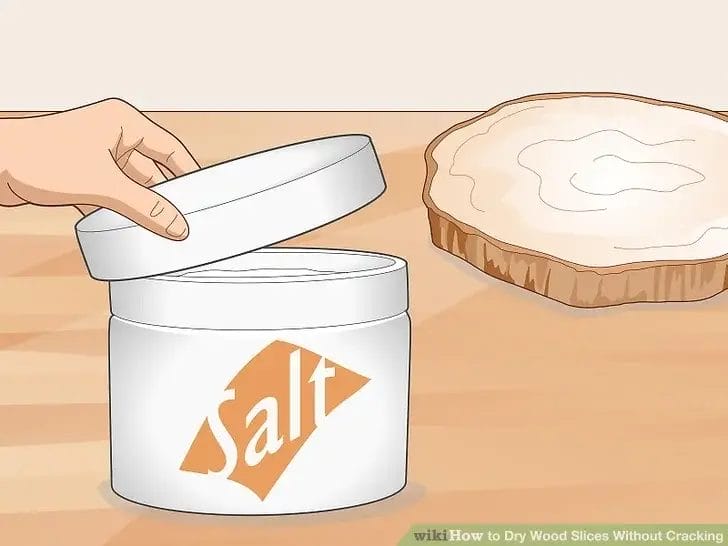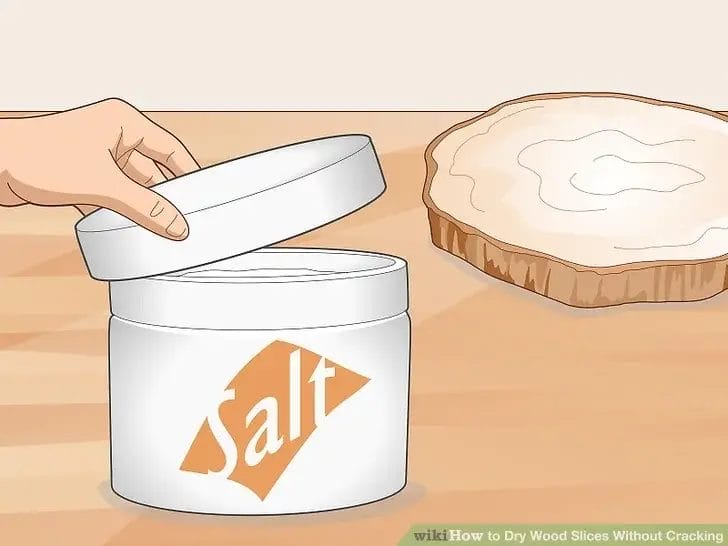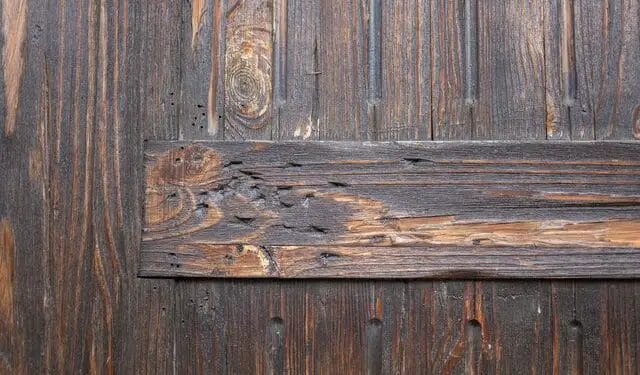Drying wood without cracking is a common concern for woodworking enthusiasts and professionals alike. Cracking can occur due to the uneven moisture content in the wood, which leads to stress and shrinkage. However, there are effective methods to minimize or prevent cracking during the wood drying process.
One important factor in preventing cracking is to ensure a gradual and controlled drying process. Rapid drying can result in abrupt moisture loss and, consequently, cracking. By allowing the wood to dry slowly, you give it time to release moisture evenly.

Proper stacking and air circulation are vital in the drying process. Stacking the lumber with spacers between each board ensures good airflow, which aids in moisture evaporation. Additionally, placing the wood in a well-ventilated area or using fans can expedite the drying process and reduce the risk of cracking.
Monitoring the moisture content of the wood is crucial. Investing in a moisture meter allows you to regularly check the moisture levels and ensure that the wood is drying uniformly. This helps in identifying any potential problem areas and adjusting the drying conditions accordingly.
Using a drying sealant or end grain sealer is another effective technique to minimize cracking. These products seal the ends of the wood, reducing moisture loss and preventing cracks from forming. Applying the sealant as soon as possible after cutting the wood helps to maintain its moisture balance.
Lastly, it is essential to choose the right time to harvest or

Effective Kiln Drying Methods for Wood
Wood is a versatile and widely used material in various industries, such as construction, furniture manufacturing, and woodworking. However, before wood can be utilized for these purposes, it needs to undergo a drying process to reduce moisture content. Kiln drying is one of the most commonly used methods to achieve this.
Kiln drying involves the use of a controlled environment, typically a kiln, to extract moisture from the wood. This process helps to minimize the risk of warping, cracking, and degradation of the wood, resulting in a more stable and usable end product. Here are some effective kiln drying methods that can be applied to ensure optimal results:
1. Air Drying
Air drying is the initial step in the kiln drying process. It involves stacking and exposing the freshly cut wood to natural air circulation. This method allows the moisture content to gradually decrease over time. Air drying is typically done in a covered area or open space with good air circulation and protection from direct sunlight and rain. It is important to properly stack the wood to promote airflow and prevent mold growth.
2. Pre-Drying
Pre-drying is a technique used to remove the initial moisture from the wood before it enters the kiln. This step helps to reduce the overall drying time required in the kiln, thereby increasing efficiency. Pre-drying can be done using various methods such as using fans or dehumidifiers to facilitate faster moisture evaporation.
3. Kiln Drying
The kiln drying process involves placing the pre-dried wood in a specially designed kiln where temperature, humidity, and airflow are carefully controlled. Kilns can be categorized into two broad types: conventional kilns and vacuum kilns.
Conventional kilns use heat and airflow to extract moisture from the wood. Temperatures typically range from 130 to 180 degrees Fahrenheit (54 to 82 degrees Celsius). The wood is exposed to a gradually increasing temperature, and the moisture is released through vents or a dehumidification system. This drying method is effective for most types of wood.
Vacuum kilns, on the other hand, operate under low pressure and use a combination of heat and vacuum to extract moisture. The reduced pressure allows water to evaporate at lower temperatures, resulting in a gentler drying process. This method is particularly suitable for sensitive and valuable wood species.
4. Moisture Monitoring
Throughout the kiln drying process, it is essential to monitor the moisture content of the wood to ensure optimal results. Moisture meters are commonly used to measure the moisture levels at different stages. Regular monitoring allows adjustments to be made to the drying parameters to achieve the desired moisture content.
5. Conditioning
Once the wood reaches the desired moisture content, it is important to condition it before being used. Conditioning involves storing the dried wood in a climate-controlled environment to allow the moisture to redistribute evenly within the wood. This step helps to reduce any moisture differentials that may have occurred during the drying process, minimizing the risk of future warping or cracking.
In summary, effective kiln drying methods for wood involve a combination of air drying, pre-drying, controlled kiln drying, moisture monitoring, and conditioning. These methods ensure the removal of moisture from the wood while minimizing the risk of damage or defects. By implementing these techniques, industries can produce high-quality, stable, and usable wood products.

Natural and Sustainable Wood Drying Solutions
Wood drying is an essential process in the woodworking industry that involves reducing the moisture content of the wood to make it suitable for various applications. Traditionally, this process has been carried out using conventional methods such as air drying and kiln drying. However, these methods often rely on artificial heating and can have negative impacts on the environment. In recent years, there has been a growing demand for natural and sustainable wood drying solutions that minimize energy consumption and reduce carbon emissions. In this section, we will explore some of these innovative drying techniques.
1. Solar Kiln Drying
Solar kiln drying is a sustainable alternative to conventional kiln drying that utilizes solar energy to heat and dry wood. This method involves constructing a specially designed kiln that captures solar radiation and converts it into heat to dry the wood. Solar kilns typically consist of a transparent roof and insulated walls that trap the solar energy while allowing airflow. The heat generated by the sun’s rays raises the temperature inside the kiln, accelerating the drying process. Solar kiln drying not only reduces the carbon footprint but also eliminates the need for fossil fuel-based heating, making it an environmentally friendly solution.
2. Vacuum Drying
Vacuum drying is a technique that involves removing moisture from wood by subjecting it to low pressure and temperature. In this process, wood is placed inside a vacuum chamber, and the air pressure is reduced, causing water to evaporate at lower temperatures. The vacuum also helps to speed up the drying process by reducing the boiling point of water. This method is highly efficient and requires less energy compared to conventional drying methods. Moreover, vacuum drying helps to minimize the risk of defects such as checking and warping, resulting in higher quality dried wood.
3. Radio Frequency Drying
Radio frequency (RF) drying is an innovative wood drying technique that utilizes electromagnetic waves to remove moisture from wood. In this process, wood is placed inside an RF chamber, and high-frequency electromagnetic waves are applied, causing the water molecules within the wood to vibrate and generate heat. This heat effectively removes moisture from the wood without causing significant damage. RF drying is known for its rapid and uniform drying, resulting in higher productivity and energy efficiency. Additionally, this method can be used to dry wood with high moisture content, reducing the need for pre-drying.
4. Air Drying with Natural Ventilation
Air drying with natural ventilation is one of the oldest and simplest methods of drying wood. This process involves stacking the wood in a well-ventilated area exposed to natural airflow. The wind and sun help to remove moisture from the wood gradually over time. Although air drying is a slower process compared to other methods, it is energy-efficient and does not require any artificial heating. Air drying with natural ventilation is particularly suitable for drying large timber, where slow and controlled drying is preferred to prevent cracking and other defects.
5. Biomass Drying
Biomass drying involves utilizing waste biomass as a source of heat for drying wood. This method utilizes organic waste materials such as wood chips, sawdust, or agricultural residues as a fuel source in specially designed drying systems. The biomass is burned to generate heat, which is then used to dry the wood. Biomass drying offers a sustainable solution by reducing waste and utilizing renewable energy sources. Moreover, the combustion of biomass can be carbon-neutral or even carbon-negative, depending on the source of the biomass.
In summary, natural and sustainable wood drying solutions are gaining popularity in the woodworking industry. These innovative techniques not only reduce energy consumption and carbon emissions but also result in higher quality dried wood. From solar kiln drying to biomass drying, there are various options available for woodworkers to choose from, depending on their specific requirements. By adopting these environmentally friendly drying methods, the woodworking industry can contribute to a greener and more sustainable future.

Expert Tips for Preventing Cracks during Wood Drying
Wood drying is an essential process to prepare lumber for various applications, such as furniture making, construction, and woodworking projects. However, one common issue that woodworkers face during the drying process is the development of cracks in the wood. Cracks can significantly reduce the quality and usability of the wood, leading to wasted time, effort, and materials. To help you prevent cracks during wood drying, we have gathered some expert tips and techniques that will ensure the successful drying of your lumber.
1. Proper Air Circulation
Ensuring proper air circulation is crucial to prevent cracks in wood during drying. Stacking the wood with adequate spacing between boards allows air to flow freely around each piece, facilitating even drying. Avoid overcrowding the woodpile, as it restricts airflow and increases the chances of cracks.
2. Gradual Moisture Reduction
Avoid rapid moisture reduction in the wood, as it can cause stress and lead to cracks. Gradually reducing the moisture content allows the wood fibers to adjust and minimize the risk of cracking. Use a moisture meter to regularly monitor the moisture levels and ensure a controlled drying process.
3. End Sealing
Applying an end sealer or wax to the ends of the wood logs or boards helps prevent moisture loss through the ends, which is a common cause of cracks. The end sealer creates a barrier that slows down moisture evaporation, allowing for more controlled drying and minimizing the risk of cracks.
4. Proper Stack Orientation
The orientation of the wood stack plays a significant role in preventing cracks. When stacking the wood, it is essential to alternate the direction of the grain on each layer. This alternating pattern distributes the stress evenly throughout the stack, reducing the likelihood of cracks forming.
5. Controlled Temperature and Humidity
Controlling the temperature and humidity levels in the drying environment is important for preventing cracks. High temperatures and low humidity can cause rapid moisture loss, leading to stress and cracks in the wood. Use dehumidifiers, fans, or air conditioning to maintain a stable and optimal drying environment.
6. Slow Drying Method
Opting for a slow drying method, such as air drying or kiln drying with extended schedules, can significantly reduce the risk of cracks. Slow drying allows the wood to adjust gradually, minimizing stress and preventing the formation of cracks. Patience is crucial during the drying process to ensure the best results.
7. Minimize Defects in the Wood
Before starting the drying process, inspect the wood for any defects, such as knots or cracks. Remove or repair any visible defects to prevent further issues during drying. Minimizing defects in the wood improves its overall stability and reduces the chances of cracks developing.
8. Regular Monitoring
Regularly monitor the drying process to identify any potential issues early on. Check for signs of stress, such as checking or warping, and make necessary adjustments to the drying conditions. Monitoring allows you to intervene promptly and prevent cracks from forming or worsening.
9. Proper Storage
After the wood has dried, proper storage is essential to maintain its quality and prevent cracks in the future. Store the wood in a dry and well-ventilated space, away from direct sunlight and moisture sources. Keeping the wood properly stacked and protected will ensure its longevity and usability.
In summary, preventing cracks during wood drying requires attention to several important factors. Ensuring proper air circulation, gradual moisture reduction, end sealing, proper stack orientation, controlled temperature and humidity, slow drying methods, minimizing defects, regular monitoring, and proper storage are key practices that can help you achieve successful wood drying without cracks. Implementing these expert tips will lead to high-quality, crack-free lumber that is ready for your woodworking projects.
Understanding the Science behind Wood Drying and Crack Prevention
Wood is a versatile and widely used material in various industries, including construction, furniture manufacturing, and crafts. However, one common issue that woodworkers encounter is the drying process, which can lead to cracks and deformations in the wood. To prevent these problems, it is important to understand the science behind wood drying and implement proper techniques to ensure a successful outcome.
The Role of Moisture Content
Moisture content is a critical factor that affects the stability and durability of wood. Wood cells contain water, and when the wood is harvested, it is considered “green” or freshly cut with a high moisture content. The drying process aims to remove this excess moisture to achieve the desired moisture content for the specific application of the wood.
When wood dries, moisture evaporates from the cell walls, causing the wood to shrink. This shrinkage can lead to stress within the wood structure and eventually result in cracks. Proper drying techniques are essential to minimize this risk and ensure the wood retains its integrity.
The Science of Wood Drying
Wood drying involves two main processes: surface drying and internal drying. Surface drying occurs when moisture evaporates from the wood’s exterior, while internal drying happens when moisture travels from the core of the wood towards the surface.
During surface drying, the wood’s surface loses moisture faster than the core, creating a moisture gradient. This gradient can cause stress within the wood, leading to surface checks or small cracks. To prevent this, woodworkers often use drying techniques that promote a gradual and balanced moisture loss throughout the wood.
Internal drying is a more complex process. As moisture moves from the core to the surface, it creates tension within the wood structure. If the drying process is too rapid or uneven, this tension can result in larger cracks and deformations. To minimize these risks, woodworkers employ various drying methods, including air drying, kiln drying, and hybrid methods that combine both approaches.
Preventing Cracks during Drying
To prevent cracks and ensure successful wood drying, several techniques can be employed:
- Slow and Controlled Drying: Gradual drying under controlled conditions helps minimize stress and allows the wood to adjust to the moisture loss more uniformly.
- Proper Stacking and Ventilation: Stacking the wood properly with adequate spacing between the boards promotes airflow, allowing moisture to escape evenly from all sides.
- Regular Moisture Content Monitoring: Monitoring the moisture content of the wood throughout the drying process enables woodworkers to make adjustments as needed and prevent over-drying or under-drying.
- Humidity and Temperature Control: Maintaining optimal humidity and temperature levels in the drying environment helps ensure a controlled and efficient drying process.
- Sealing End Grain: Sealing the cut ends of the wood with a suitable sealer or wax helps prevent moisture loss from the ends, reducing the risk of end grain cracks.
- Proper Storage and Conditioning: After drying, allowing the wood to acclimate and stabilize in a controlled environment before its final use helps minimize the risk of post-drying deformations.
In summary, understanding the science behind wood drying is crucial for preventing cracks and deformations. Proper drying techniques, such as slow and controlled drying, adequate ventilation, and regular moisture content monitoring, can help minimize the risks associated with wood drying. By implementing these techniques, woodworkers can ensure the stability, durability, and aesthetic appeal of the wood in various applications.
FAQs
How can I dry wood without it cracking?
To dry wood without cracking, you can follow these steps: 1. Seal the ends of the wood to prevent moisture loss. 2. Store the wood in a cool, dry place with good air circulation. 3. Use a moisture meter to monitor the moisture content of the wood. 4. Gradually increase the temperature and decrease the humidity in the drying environment. 5. Allow the wood to dry slowly over a period of several months.
Conclusion
In conclusion, drying wood without cracking is essential for preserving its quality and durability. By following the proper techniques, you can ensure that your wood remains intact and ready for use in various applications.
One important method is to dry the wood slowly and evenly, allowing moisture to escape gradually. This can be achieved through air-drying or kiln-drying processes. Additionally, sealing the ends of the wood with wax or paint helps prevent rapid moisture loss, reducing the risk of cracking.
Furthermore, maintaining optimal humidity levels in the drying environment and using proper stacking techniques also contribute to successful wood drying. By implementing these practices, you can minimize the chances of wood cracking and maximize the longevity of your wooden projects.